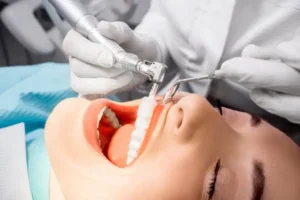Introduction
When you hear the word “root canal,” you often think of anxiety and discomfort. However, understanding endodontic treatment and root canal procedures can alleviate fears about extractions, as root canals are essential dental procedures for saving teeth. Let’s explore what endodontic treatment entails, its benefits, and the specific procedures involved.
What Is Endodontic Treatment?
Endodontic treatment is a specialized dental field that focuses on conditions with the soft inner tissue of the tooth, known as the pulp, as well as the surrounding tissues near the tooth’s root. The word “endodontic” originated from the Greek terms “endo,” meaning within or inside, and “odont,” which refers to a tooth. Essentially, endodontic treatment involves working inside the tooth to address problems that affect its health and function.
What Is a Root Canal?
One of the most frequently performed endodontic procedures is a root canal treatment. The procedure is carried out when the dental pulp, the tooth’s soft inner tissue, which holds the nerves, blood vessels, and connective tissue, becomes inflamed or infected.
This inflammation or infection can arise from severe tooth decay, multiple dental procedures performed on the same tooth, improperly fitted crowns, or cracks or chips in the tooth structure. If left unaddressed, the infection can result in pain and potentially lead to the formation of an abscess.
The Root Canal Procedure
Knowing the steps involved in a root canal procedure could help with alleviating anxiety. Here’s a detailed look at each phase of the treatment:
Diagnosis and Consultation:
- Initial Examination: The dentist or endodontist begins with a comprehensive examination of the tooth. This often includes taking X-rays to evaluate the extent of the damage and to determine the shape of the root canals.
- Symptom Assessment: The dental professional will discuss symptoms such as pain, swelling, and sensitivity to determine whether a root canal is necessary.
Anesthesia:
- Local Anesthesia: Local anesthesia numbs the damaged tooth and surrounding tissues, ensuring the patient’s comfort and pain-free experience during the treatment.
- Patient Comfort: Throughout the procedure, the dentist will ensure the patient remains comfortable, adjusting anesthesia as needed.
Access Opening:
- Creating an Opening: To gain access to the infected or inflamed pulp, a tiny incision is cut into the tooth’s crown. This opening is typically made on the chewing surface of the back teeth or the back side of the front teeth.
- Isolation: A rubber dam is utilized to isolate the tooth and keep it dry and saliva-free during the process.
Cleaning and Shaping:
- Removing Infected Pulp: The dentist uses specialized dental equipment to carefully remove infected or inflammatory pulp from the pulp chamber and root canals.
- Cleaning the Canals: The root canals are thoroughly cleansed and disinfected to remove any leftover bacteria and debris.
- Shaping the Canals: The canals are then shaped to allow for proper filling. This step ensures that the canals can be completely sealed to prevent future infection.
Filling the Canals:
- Biocompatible Material: Once the canals are cleaned and shaped, they are filled with a rubber-like, biocompatible material called gutta-percha. This material is placed into the canals with adhesive cement to provide a complete closure.
- Temporary Filling: If the procedure requires several visits, a temporary filling may be placed through the access opening to preserve the tooth in the meantime.
Restoration:
- Permanent Restoration: After the root canal is performed, the tooth must be restored to full function. This usually involves placing a crown over the tooth to protect it from future damage and restore its strength and appearance.
- Filling: If the tooth structure is sufficient, a permanent filling may be used instead of a crown. However, crowns are more commonly recommended for teeth that have undergone root canals, especially molars and premolars.
Post-Treatment Care
Follow-Up:
- Regular Check-Ups: Following a root canal operation, regular dental check-ups are required to monitor the health of the treated tooth and surrounding tissues.
- X-Rays: Follow-up X-rays may be performed to ensure routine healing and to detect any evidence of re-infection.
Oral Hygiene:
- Brushing and Flossing: Proper oral hygiene, such as brushing twice a day and flossing every day, will help avoid future dental problems.
- Avoiding Hard Foods: Patients should avoid chewing on complex meals with their treated teeth until the permanent restoration is done.
Endodontic Treatment Benefits
Endodontic treatment, additionally referred to as root canal therapy, provides numerous benefits that improve overall oral health and well-being. Understanding these benefits can help patients appreciate the value of this vital dental procedure.
- Pain Relief: Immediate relief from pain caused by an infected or inflamed dental pulp. Long-term comfort is achieved by addressing the underlying cause of pain.
- Tooth Preservation: Saves the natural tooth, avoiding the need for extraction. Maintains normal biting and chewing functionality.
- Aesthetic Benefits: It preserves the patient’s smile by keeping the natural tooth intact. It prevents gaps in the smile that could require additional dental work.
- Prevention of Further Infection: This stops the spread of infection to adjacent teeth and tissues, contributing to a healthier overall oral environment.
- Restoration of Oral Health: This procedure restores the tooth to a healthy state, supporting the health of surrounding teeth and gums. It enhances the patient’s quality of life by allowing normal eating, speaking, and smiling.
- Cost-Effective Solution: More cost-effective than extraction and replacement options. Avoids long-term costs associated with tooth loss and additional restorations.
- Durability: A treated tooth can last a lifetime with proper care. Crowns or fillings add strength and stability to the treated tooth.
Who Needs Endodontic Treatment?
Endodontic treatment, particularly root canal therapy, is essential for individuals experiencing specific dental issues that affect the health of the tooth pulp. Here are the primary indicators that someone might need endodontic treatment:
- Severe Tooth Pain: Persistent, severe toothache that doesn’t subside with over-the-counter pain relievers and intensifies when biting down.
- Prolonged Sensitivity: A sensitivity to hot or cold temperatures that lasts even after the cause has been eliminated.
- Swelling and Tenderness: Swelling and discomfort in the gums or jaw around the damaged tooth.
- Tooth Discoloration: The darkening or discoloration of an impacted tooth that does not improve with regular dental cleanings.
- Gum Issues: A recurring pimple on the gums near the affected tooth or pus discharge indicating an abscess.
- Previous Dental Work: Teeth with extensive decay or damage, previously treated with large fillings or crowns, showing signs of pulp infection.
If you experience any of these symptoms, it is crucial to consult a dentist or endodontist promptly. Early diagnosis and treatment can save the tooth and prevent further complications.
Conclusion
Understanding endodontic treatment and root canal procedures can help clarify the crucial dental practice of root canals, which are vital for tooth preservation and oral health. At Stratland Dental in Glendale, AZ, Dr. Ricky Marshall uses state-of-the-art technology and personalized care to provide gentle, effective endodontic treatments that remove damaged or infected pulp, clean and seal the tooth to prevent future infections, and alleviate symptoms like severe tooth pain, sensitivity, and swelling, ultimately preserving your natural teeth and enhancing your oral health. Experience pain relief and maintain your smile with our advanced endodontic treatments. At our dental office Glendale AZ, Dr. Ricky Marshall provides expert endodontic treatments, utilizing advanced technology to alleviate pain and preserve your natural teeth effectively.







